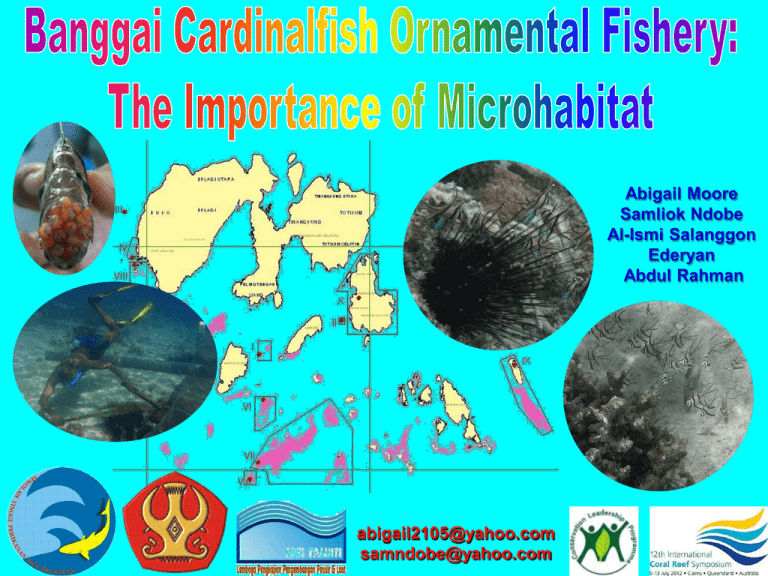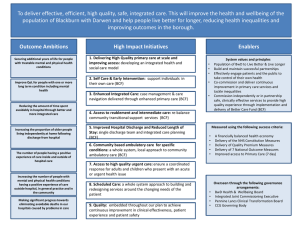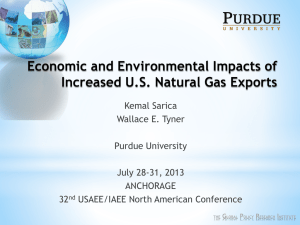10:15 Moore A - 12th International Coral Reef Symposium
advertisement

Abigail Moore Samliok Ndobe Al-Ismi Salanggon Ederyan Abdul Rahman abigail2105@yahoo.com samndobe@yahoo.com I. Background - BCF II. Materials and Methods III. The BCF Fishery IV. The BCF Trade V. BCF Habitat & Population VI. Conclusion Acknowledgement Special thanks to the people and organisations who were directly involved in the survey and monitoring activities or provided data and information, financial, in-kind or moral support for the preparation and presentation of this paper. Conference attendance supported by the Conservation Leadership Programme (AM) and a 12th ICRS student grant (SN). Banggai cardinalfish (BCF) Pterapogon kauderni Kendari Restricted range endemic species IUCN Red List: Endangered Distribution: ± 5500km2 Habitat: 30-34 km2 Population: ± 2.4 million (Vagelli, 2005) 6 1 Need for Monitoring and Evaluation Coral-reef associated: Habitat (coastal waters < 5m depth) intensive use - threatened Microhabitat threatened changes in the ornamental fishery conservation outlook for P. kauderni, the causes and impacts of habitat degradation. Vulnerable to Extinction: District MPA Paternal mouthbrooder with direct development No pelagic phase Sedentary & high site fidelity extremely easy to catch Relatively low fecundity High risk of local extinction IUCN Red List - Endangered 2 5 10 Islands 2 islands designated for BCF conservation Only 1 of these has a BCF population 4 National Initiatives: National BCF Action Plan- multi-stakeholder, multi-year (2007-2012) Indonesian NPOA CTI-CFF (National Plan of Actions - Coral Triangle Initiative on Coral Reef, Fisheries and Food Security): Target 4, Action 3 National legislation: in process 3 Ornamental Fish - International Concern: Traded since late 1980's High (600,000 to 1.4 million/year) volume relative to estimated total population (2.4 million) Long & complex trade routes & high mortality International concern (CITES proposal in 2007, articles, anti-wild-caught BCF campaigns) National and International Issue Considered endangered by overfishing for the marine aquarium trade 2007: Proposed for CITES Appendix II listing (by the USA) - withdrawn 2007: Listed as Endangered in the IUCN Red List Indonesia - commitment to BCF conservation & sustainable use BCF AP & BCF conservation in Indonesian Coral Triangle initiative Plan of Actions (NPOA) o o o Local Actions: Community MPA (Bone Baru) Ongoing research Umbrella organisation: Banggai Cardinalfish centre (BCFC) established (2007) o Monitoring (Moore et al. in press) o Ongoing efforts to achieve a sustainable ornamental fishery o District MPA network (2007) Primary data on BCF (P. kauderni) biology, ecology, fishery, and trade: BCF-AP activities 2007-2011 Other field visits/research programs 2004 to 2012 Secondary data: Fish Quarantine records Banggai Cardinalfish Centre (BCFC): trade monitoring scheme (2008 & 2009) by the Marine and Fisheries Research Agency (BRKP), District Marine and Fisheries Service (MFS) & ornamental fishing community Other BCF-AP government & non-government stakeholders (LINI etc) Data analysed/reviewed to identify: changes in the P. kauderni fishery and trade conservation status/outlook for P. kauderni populations/habitat Collecting Villages & Fishers Multiple livelihood strategies 2001: around 12 BCF collecting villages Collecting BCF(Lunn & Moreau, 2004) 2011: 3 villages regularly collecting BCF o Two villages consistently collecting/trading BCF: Bone Baru & Bone Bone o Other villages: main reason for changes = buyers o Roving fishers (illegal) still a major problem Island or Sub-District Banggai Bokan Kepulauan Bangkurung Other Village Bone Baru Tinakin Laut Monsongan Tolokibit Matanga Toropot Panapat Kokudang MbuangMbuang Bone Bone Dunkean 4 villages with very low volume 2001* A A A A A A A A Status ** 20062004 2009 A A A N A N A N no data N A A A P N N 2011 A N N A N N N N A N N N A A A N A N A N A N N N Fishing Grounds 2004-2011 ??? Reduction? June 2012... 2001: Lunn & Moreau 2004: EC-PREP 2006: Sea Partnership (PMB) 2008/2009: MMAF etc monitoring (3 villages) 2008-now: Fish Quarantine data 2010, 2011, 2012 surveys o Changes in routes o Trader bases o Infrastructure o e.g. Luwuk-Jakarta (&Denpasar) o Quota system (2010): 15,000/month (problems) o Roving fishers still a problem o Competition - captive-bred fish Bone Bone To Jakarta or Bali by Air Parameter Year Bone Baru Toropot No. BCF caught 2008 162,940 73,433 no data 236,373 2009 155,156 89,340 85,920 330,416 Mortality (%) 2008 2.60% 0.70% no data 2009 0.10% 0.30% 0.80% 2008 (Feb-Dec) 2009 2010 2011 (to June) Number of fish traded legally 83,200 215,950 148,800 56,900 2.00% Average monthly volume* 7,564 17,996 12,400 9,483 0.30% % enumerator trade data 36% 66% n/a n/a Total Parameter Trade - Trends Increase in legal trade Decrease in illegal trade Decrease in destructive practices (especially take of brooding males) Decrease in size range and maximum/minimum sizes (target size now 2.5-3.5cm SL) Decrease in mortality (improved handling) Increase in price to fishers Improved organisational structure (fisher group) MORE SUSTAINABLE Coral reef degradation widespread, many causes (Moore & Ndobe, 2009: data 2004, 2006, 2007) 2011: coral cover decline 2004-2011 at 5 sites around Banggai Island (e.g. 25% to 11%, Bone Baru transect) Threats mostly at similar levels or increasing: o gleaning of invertebrates for consumption (intensive, but often not perceived as fishing) and sale (abalone) o general fishing pressure, including destructive methods (illegal & legal or unregulated) o coastal development (sea walls, public infrastructure, replacement of traditional homes) o illegally mined coral and sand by public works and local communities Pressure on the land-based resources: o sedimentation, deleterious changes in hydrology, and water quality issues. Acanthaster plancii outbreaks Temperature-related coral bleaching not observed or reported up to December 2011, despite extensive bleaching in nearby Tomini Bay in 2010 Kolm and Berglund (2003): heavy fishing pressure correlated with lower P. kauderni population density no significant difference between lightly/ moderately fished sites and un-fished sites Confirmed by more recent survey/monitoring of endemic and Palu Bay introduced populations All levels of fishing alter population structure: o higher percentages of recruits and smaller juveniles consistently observed at sites recently or regularly fished. o negative relationship between BCF density and juvenile:adult ratio - 6 sites around Banggai Island with various levels of fishing pressure o predation of newly released recruits by adult BCF (cannibalism) recorded in captivity (2010) and witnessed in the wild (2011&2012) o many indications that the survival rate of new recruits increases when the density of adult and sub-adult fish is reduced whether by fishing or other causes such as severe weather Study of microhabitat use by P. kauderni of 3 age/size classes (recruits: SL 6-15mm; juveniles SL 16-35mm; adults SL >35mm) o All size classes found in Diadema microhabitat, age structure close to overall population sampled. o Recruits comprised 80% of all P. kauderni associated with sea anemones o All recruit groups of more than 3 individuals, were associated with sea anemones, often also inhabited by clownfish (Amphiprion sp.) o Adults/large juveniles in hard coral microhabitat o Isolated recruits have been seen in branching or foliose corals as well as mushroom corals of the Genus Heliofungia Predation of exposed P. kauderni recruits by fish of the Families Scorpaenidae, Labridae, Cirrhitidae and Gobiidae immediately or shortly after release from the male parents buccal pouch small stonefish (Scorpaenidae) in unusually high numbers around male P. kauderni brooding welldeveloped larvae, subsequently predating recruits Microhabitat: refuge from predation Anemones: particularly important for new recruits o nearly all predators, including adult and sub-adult P. kauderni, seem to avoid the tentacles among which the smaller P. kauderni often hide, also benefitting from protection of the anemone by resident clown fish when present. o brooding males close to releasing their larvae have been observed near anemones, later found to be occupied by P. kauderni recruits. o often groups of 20 or more P. kauderni recruits in one sea anemone (sea urchins: groups of 1-3) o link with recruit release patterns? 2007: first observed massive extraction (increase in longstanding practices) of key recruit microhabitat - drastic decline in P. kauderni population - sea anemones at Tinakin Laut; sea urchins in Tolokibit P. kauderni recruits and small juveniles fell by an order of magnitude at Mamboro in Palu Bay after sea anemones were collected by local children Reduction in sea urchin & sea anemone populations at another site in Palu Bay (cause unknown): almost all BCF crowded into the remaining urchins were adults. No recruits or small juveniles, despite large numbers of brooding males, indicating a sharp drop in recruit/juvenile survival 2009: seaweed farming related to shifts in fishing and consumption patterns: intensive harvesting of all edible benthic invertebrates including urchins/anemones 2011: sea urchins also harvested as feed for carnivorous fish (LRFT) especially Napoleon wrasse Urchin & anemone decline: BCF decline, fished AND nonfished sites - 2012... Many improvements in the BCF fishery and trade o Technical o Organisational o Economic Should be approaching a SUSTAINABLE ORNAMENTAL FISHERY BUT... In a review of marine biodiversity patterns, threats and conservation needs, Gray (1997) stated that "loss of habitat is the most serious threat to marine biodiversity" MICROHABITAT LOSS is now the major threat to BCF Conservation o Recent threat, caused by socio-economic changes o Involves many stakeholders who are unaware of the BCF - the species, the fishery, the conservation issues o Need for innovative solutions - including socialisation o Need for research & monitoring o Potential role of the BCFC - empower to co-ordinate (government, communities, scientists, etc) abigail2105@yahoo.com samndobe@yahoo.com Abigail Moore Samliok Ndobe Al-Ismi Salanggon Ederyan Abdul Rahman





